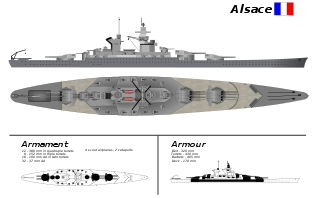 W
WThe Alsace class was a group of two fast battleships planned by the French Navy in the late 1930s in response to German plans to build two H-class battleships after the Second London Naval Treaty collapsed. The Alsace design was based on variants of the Richelieu class, and three proposals were submitted by the design staff. The proposed armament included nine or twelve 380 mm (15 in) guns or nine 406 mm (16 in) guns, but no choice was definitively made before the program ended in mid-1940. According to one pair of historians, logistical considerations—including the size of the 12-gun variant and the introduction of a new shell caliber for the 406 mm version—led the naval command to settle on the nine 380 mm design. But another pair of authors disagree, believing that the difficulty of designing and manufacturing a three-gun turret would have caused prohibitive delays during wartime, making the third, largest variant the most likely to have been built. The ships would have forced the French government to make significant improvements to its harbor and shipyard facilities, as the smaller Richelieus already stretched the limitations of existing shipyards. With construction of the first member of the class scheduled for 1941, the plan was terminated by the German victory in the Battle of France in May–June 1940.
 W
WThe Amur-class submarine, is one of the latest Russian submarine designs. It is advertised as an export version of the Lada class, a modernized version of the Kilo-class submarine with improved acoustic stealth, new combat systems, and an option for air-independent propulsion (AIP).
 W
WThe Anti-Submarine Warfare Frigate (ASWF) is a project of the Royal Netherlands Navy and Belgian Navy to replace the existing Multipurpose- or M-frigates. The project shows similarities to the British Global Combat Ship but development is fully separate.
 W
WThe Arafura class is a multipurpose small warship class for the Royal Australian Navy (RAN). Initially proposed in the 2009 Defence White Paper and marked as procurement project SEA 1180, it was originally planned that 20 Offshore Combatant Vessels (OCV) would replace 26 vessels across four separate ship classes: the Armidale-class patrol boats, the Huon-class minehunters, the Leeuwin-class survey vessels, and the Paluma-class survey motor launches. Although having a common design, the ships would use a modular mission payload system to fulfill specific roles; primarily border patrol, mine warfare, and hydrographic survey. The 2013 Defence White Paper committed to the OCV project as a long-term goal, but opted in the short term for an accelerated procurement of an existing design to replace the Armidales, and life-extension refits for the other types. This resulted in the Offshore Patrol Vessel (OPV) project and the amount of vessels reduced to 12. However, this was further increased to 14 when 2 further Mine Counter Measures variants were proposed under SEA 1905.
 W
WThe Attack-class submarine is a future class of submarines for the Royal Australian Navy, expected to enter service in the early 2030s with construction extending into the late 2040s to 2050. The Program is estimated to cost $90 billion and will be the largest, and most complex, defence acquisition project in Australian history.
 W
WAurora Borealis is a proposed European research icebreaker, comparable to the world's strongest icebreakers, planned jointly by a consortium of fifteen participant organizations and companies from ten European nations. If built, she would be the largest icebreaker ever built as well as the first icebreaker built to the highest IACS ice class, Polar Class 1.
 W
WThe Benetti Fisker 50 is a 50-meter (164-foot) superyacht concept designed by Henrik Fisker in California, to be built by Italian boat building company Benetti in Livorno. Fisker and Benetti announced a partnership in 2015 to design and build a series of superyachts and revealed the design at the 2016 Singapore Yacht Show.
 W
WThe Borodino-class battlecruisers were a group of four battlecruisers ordered by the Imperial Russian Navy before World War I. Also referred to as the Izmail class, they were laid down in late 1912 at Saint Petersburg for service with the Baltic Fleet. Construction of the ships was delayed by a lack of capacity among domestic factories and the need to order some components from abroad. The start of World War I slowed their construction still further, as the imported components were often not delivered and domestic production was diverted into areas more immediately useful for the war effort.
 W
WDesign A-150, popularly known as the Super Yamato class, was a planned class of battleships for the Imperial Japanese Navy. In keeping with the Navy's long tradition, they were designed to be qualitatively superior to battleships that might be faced in battle, such as those from the United States or Great Britain. As part of this, the class would have been armed with six 51-centimeter (20.1 in) guns, the largest weapons carried aboard any warship in the world. Design work on the A-150s began after the preceding Yamato class in 1938–1939 and was mostly finished by early 1941, when the Japanese began focusing on aircraft carriers and other smaller warships in preparation for the coming conflict. No A-150 would ever be laid down, and many details of the class' design were destroyed near the end of the war.
 W
WDesign B-65 was a class of Super Type A cruisers planned by the Imperial Japanese Navy (IJN) before and during World War II. As envisioned by the IJN, the cruisers were to play a key role in the Night Battle Force portion of the "Decisive battle" strategy which Japan hoped, in the event of war, to employ against the United States Navy.
 W
WThe Dosan Ahn Changho-class submarines are the final phase of the Korean Attack Submarine program, a three-phased program to build 27 attack submarines for the Republic of Korea Navy between 1994 and 2029. The lead vessel, Dosan Anh Changho, was launched in 2018. It began sea trials in 2019 and planned to be ready for service by 2020.
 W
WThe Ersatz Monarch class was a class of four dreadnought battleships which were intended to be built between 1914 and 1919 for the Austro-Hungarian Navy. Design work on a class of battleships to succeed the Tegetthoff class and replace the aging Monarch class began in 1911. After going through several different design proposals, Anton Haus, Commander-in-Chief of the Austro-Hungarian Navy, secured passage of a naval expansion program through the Austro-Hungarian government to fund the construction of the battleships in April 1914.
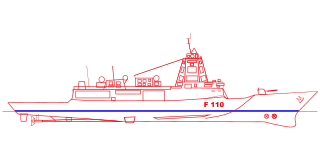 W
WThe F110 class also known as the Bonifaz class are a multi-purpose, anti-submarine class of Aegis combat system-fitted heavy frigates under development for the Spanish Navy. The project is being co-developed by the Spanish Ministry of Defence and the state owned company Navantia. The construction of the frigates is to begin by 2020 and are scheduled to be delivered between 2023 and 2027.
 W
WFincantieri 6274 is the yard name for a cruise ship under construction for the Cunard Line. Announced in 2017, the ship will be Cunard's fourth ship in its current fleet and the 249th ship in its history.
 W
WThe Francesco Caracciolo-class battleships were a group of four battleships designed for the Regia Marina in 1913 and ordered in 1914. The first ship of the class, Francesco Caracciolo, was laid down in late 1914; the other three ships, Cristoforo Colombo, Marcantonio Colonna, and Francesco Morosini followed in 1915. Armed with a main battery of eight 381 mm (15 in) guns and possessing a top speed of 28 knots, the four ships were intended to be the equivalent of the fast battleships like the British Queen Elizabeth class.
 W
WFreedom Ship was a floating city project initially proposed in the late 1990s. It was so named because of the "free" international lifestyle facilitated by a mobile ocean colony, though the project would not be a conventional ship, but rather a series of linked barges.
 W
WThe Frégate de défense et d'intervention FDI; English: Frigates for defence and intervention) ) is a French military program to design and create a planned class of frigates to be used by the French Navy. At the moment, the program consists of five ships, with commissioning now planned from 2024 onwards. The frigate-type has subsequently been identified as a "Frégate de Défense et d'Intervention" (FDI) with the lead ship being named "Admiral Ronarc’h". First steel was cut in October 2019 beginning construction on the lead unit. The lead ship was projected to be laid down in November 2021.
 W
WThe Gremyashchiy class, Russian designation Project 20385, is an update of the Steregushchiy-class corvettes of the Russian Navy. This follow-on project was designed by the Almaz Central Marine Design Bureau in Saint Petersburg. The first ship was laid down on 26 May 2011 and the official laying down ceremony took place on 1 February 2012.
 W
WThe Hunter class frigate is a future class of frigates for the Royal Australian Navy (RAN) to replace the Anzac-class. Construction is expected to begin in 2020, with the first of nine vessels to enter service in the late 2020s. The Program is expected to cost AU$35 billion and a request for tender was released in March 2017 to three contenders: Navantia, Fincantieri, and BAE Systems as part of a competitive evaluation process.
 W
WThe Ibuki-class cruisers were the last class of heavy cruisers built for the Imperial Japanese Navy (IJN). In order to save design time, the ships were essentially repeats of the earlier Mogami class. Begun during World War II, only the lead ship, Ibuki, was launched, but she was in the process of being converted into a light aircraft carrier when construction was suspended in 1945. She was scrapped the following year. The unnamed second ship was scrapped less than a month after being laid down in order to clear her slipway for an aircraft carrier.
 W
WMS Iona is an Excellence-class cruise ship set to operate for P&O Cruises, a subsidiary of Carnival Corporation & plc. Built by Meyer Werft in Papenburg, Germany, she was delivered in October 2020, becoming the line's new flagship. At 184,089 GT, the ship is the largest to ever operate for P&O Cruises, and to operate specifically for the British market. She is the first of two identical ships being built by Meyer Werft for P&O Cruises, with the second, Arvia, due to enter service in 2022.
 W
WCCGS John G. Diefenbaker is the name for a Canadian Coast Guard icebreaker that had been expected to join the fleet by 2017 but has been significantly delayed. Her namesake, John G. Diefenbaker, was Canada's 13th prime minister. It was Diefenbaker's government that founded the Canadian Coast Guard in 1962.
 W
WThe Kiev class was designed in 1939 for the Soviet Navy as a smaller class of destroyer leaders after the cancellation of the Tashkent-class ships that had been intended to be built in the Soviet Union. Only three ships were begun; one was cancelled and scrapped before the Axis invasion in mid-1941 and construction of the other two was suspended during the war. The navy considered completing them under a new Project 48-K configuration afterwards, but decided against that as they would have been competing against a more modern design that lacked the stability problems that the 48-K design would have had. The Soviets either scrapped them or used them as targets.
 W
WThe Korean Attack Submarine program, KSS meaning Submarine, is a three-phased project to build up the Republic of Korea Navy 's attack submarine arsenal. Before the KSS program, the submarine fleet of the ROK Navy consisted of midget submarines, such as the Dolgorae class submarine and SX 756 Dolphin class submarine, which had limited capabilities for inshore operations. The KSS program sought to acquire submarines that can deter hostile submarines and surface ships; protect friendly naval bases and sea shores communications; carry out reconnaissance missions.
 W
WThe La Motte-Picquet class were a planned series of light cruisers for the French Navy and named after French admiral Toussaint-Guillaume Picquet de la Motte. Although designed in 1912, the scheduled construction of La Motte-Picquet was suspended due to the outbreak of World War I before the ships could be laid down. The design would be revived and used as the basis for the Duguay-Trouin classs after the war. The name of the planned 1912 lead ship, would be reused by the French cruiser Lamotte-Picquet.
 W
WThe Lider class, also referred to it as Shkval class, Russian designation Project 23560 Lider,, is a combined stealth nuclear-powered guided missile destroyer and cruiser, under consideration for the Russian Navy. Detailed design phase began in 2016–2017, with construction expected to commence after 2020.
 W
WThe Lyon class was a set of battleships planned for the French Navy in 1913, with construction scheduled to begin in 1915. The class was to have comprised four ships, named Lyon, Lille, Duquesne, and Tourville. The first two were named for cities in France, and the latter pair honored the French admirals Abraham Duquesne and Anne Hilarion de Tourville. The Lyon class' design was an improvement on the previous Normandie class, utilizing a fourth quadruple-gun turret to mount a total of sixteen 34 cm (13.4 in) guns. Construction on the Lyons was cancelled due to the August 1914 outbreak of World War I, before any of the ships were laid down.
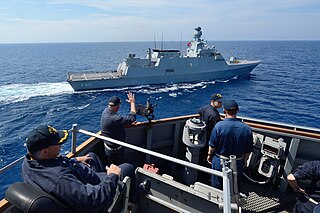 W
WMILGEM project is a national warship program of the Republic of Turkey. Managed by the Turkish Navy, the project aims at developing multipurpose corvettes and frigates that can be deployed in a range of missions, including reconnaissance, surveillance, early warning, anti-submarine warfare, surface-to-surface and surface-to-air warfare, and amphibious operations.
 W
WThe National Security Multi-Mission Vessel (NSMV) is a United States Maritime Administration (MARAD) ship designed as training vessels for the US maritime academies. The vessels will also be equipped to provide emergency humanitarian relief in areas affected by natural disasters such as hurricanes. The first ship was expected to be delivered in 2022. In April 2020, TOTE Services signed a contract with Philly Shipyard for the construction of up to five NSMVs, with the first two delivered in Spring and Winter 2023 for a cost of US$630M.
 W
WThe Nilgiri-class frigate or Project 17A is a follow-on of the Project 17 Shivalik-class frigate for the Indian Navy. A total of seven ships will be built at Mazagon Dock and GRSE. The ships have been named after the first major warships to be built in India, which in turn were named after hill ranges in India. The construction of the first ship started in 2017 and the first ship is expected to delivered by 2022. The anticipated cost for each vessel is above ₹4,000 crore (US$561 million) and the total deal is expected to be worth more than ₹45,000 crore. The vessel will incorporate the latest stealth features.
 W
WThe Normandie class consisted of five dreadnought battleships ordered for the French Navy in 1912–1913. It comprised Normandie, the lead ship, Flandre, Gascogne, Languedoc, and Béarn. The design incorporated a radical arrangement for the twelve 340 mm (13.4 in) main battery guns: three quadruple-gun turrets, the first of their kind, as opposed to the twin-gun turrets used by most other navies. The first four ships were also equipped with an unusual hybrid propulsion system that used both steam turbines and triple-expansion steam engines to increase fuel efficiency.
 W
WThe Number 64 class, also known as the Monfalcone light cruisers, was a planned class of protected cruisers ordered for the Republic of China Navy. None were completed due to the start of World War I and were eventually scrapped. The ships were not given names, being known only by their yard construction numbers, 64–66.
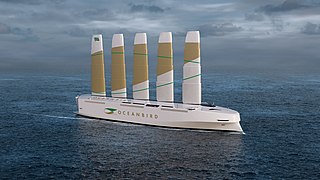 W
WOceanbird is a large, wind-powered vessel under development by Wallenius Marine. The ship design aims to lower emissions by up to 90 percent and is developed in collaboration with KTH Royal Institute of Technology and Swedish maritime technology company SSPA. Financial backing is provided by the Swedish Transport Agency.
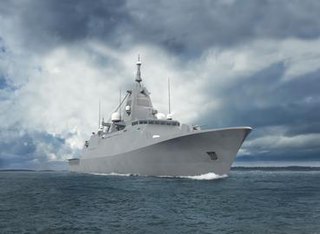 W
WPohjanmaa class is a series of four multi-role corvettes currently under development for the Finnish Navy as part of the Squadron 2020 project. Together with the existing four Hamina-class missile boats, the four new surface combatants will form the backbone of the Finnish Navy from the mid-2020s onwards. They will replace seven older vessels that have been or are due to be decommissioned: the minelayer Pohjanmaa, two Hämeenmaa-class minelayers and four Rauma-class missile boats.
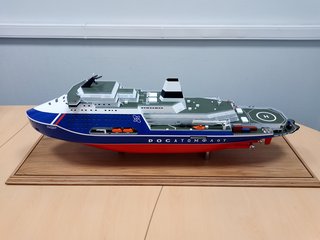 W
WProject 10510, also known through the Russian type size series designations LK-110Ya and LK-120Ya or the project name Leader, is a planned series of Russian nuclear-powered icebreakers. When built, it would supersede Project 22220 icebreakers as the largest and most powerful icebreakers in the world. As of 2020, the lead vessel of the series is under construction and expected to be commissioned by 2027. In total, it is planned to built three vessels by 2033.
 W
WProject 23550 patrol ships is a class of armed icebreaking patrol ships with two vessels currently under construction for the Russian Navy at Admiralty Shipyard in Saint Petersburg, Russia. Two ships have been ordered from the Admiralty Shipyard in 2016. The ships are designed to patrol the Russian territorial waters and exclusive economic zone in the Arctic.
 W
WMV Regent Sky was an unfinished cruise ship that travelled to several locations during her incomplete construction. She was initially being built in Poland as the cruise ferry Stena Baltica, one of four sister ships planned for the Stena Line. Still incomplete, she was purchased by Regency Cruises and moved to Greece, but her new owners filed for bankruptcy in 1995.
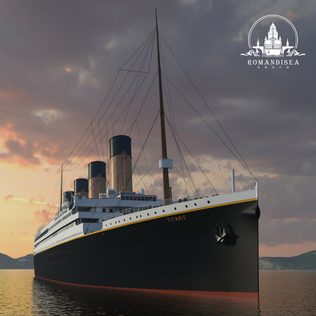 W
WThe Romandisea Titanic is an under-construction replica of the original RMS Titanic, located in landlocked Sichuan province, China. The rebuild project was first reported by media in October 2013 and formally launched in January 2014. The ship will be the same size as the original Titanic, hence 269 meters in length and 28 meters wide.
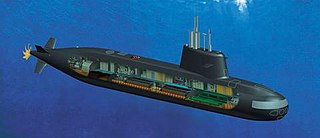 W
WThe S1000-class submarines are a joint development by Russia and Italy. It is said to be an advanced version of the Amur-class submarine of Rubin Design Bureau. The joint development is between Rubin Design Bureau of Russia and Fincantieri of Italy.
 W
WSalamis was a partially constructed capital ship, referred to as either a dreadnought battleship or battlecruiser, that was ordered for the Greek Navy from the AG Vulcan shipyard in Hamburg, Germany, in 1912. She was ordered as part of a Greek naval rearmament program meant to modernize the fleet, in response to Ottoman naval expansion after the Greco-Turkish War of 1897. Salamis and several other battleships—none of which were delivered to either navy—represented the culmination of a naval arms race between the two countries that had significant effects on the First Balkan War and World War I.
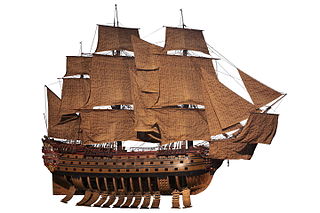 W
WSans Pareil ("Peerless") was a ship of the line project presented to Louis XV between 1757 and 1760. No actual ship of this type bore the name in the French Navy, though Royal Louis was built on the scheme.
 W
WThe SeaOrbiter, also known as Sea Orbiter, is a proposed oceangoing research vessel. Construction was due to start in 2014 but by May 2015, only the Eye of SeaOrbiter has been completed, and as of late 2019, there is no news of any other construction.
 W
WExperiment of Leith was a catamaran engineered by the Scottish banker Patrick Miller of Dalswinton, to be used by the Swedish fleet in the Russo-Swedish War (1788-90). By the time the ship reached Stockholm the war was, however, already over.
 W
WThe Streamlined Ocean Liner was a design by Norman Bel Geddes for a streamlined steam-powered ocean liner. The shape was compared by Pathé to that of a porpoise, blunt at the front and tapered at the rear. It first appeared in Geddes' 1932 book Horizons and an outline patent was filed in 1933 with a detailed patent following in 1934. An offer was made for the rights to the design in the late 1930s, which Geddes refused, as he still hoped to sell it to an American shipbuilder, but the ship was never built.
 W
WThe Tamandaré class are a new class of future general purpose frigates for the Brazilian Navy, based on the MEKO family of ships. The project is being developed by the Ministry of Defence and the Águas Azuis consortium, composed of Thyssenkrupp Marine Systems (TKMS) and Embraer Defense and Security. The construction of the four planned frigates will begin in 2021 and are scheduled to be delivered between 2025 and 2028.
 W
WThe TF-2000 class frigate is a projected anti-air warfare frigate currently undergoing development by the Turkish Naval Institute. The class will provide survivability in the presence of aerial threat and also support mission functions such as command, control, and communications, reconnaissance, early warning, surface warfare, anti-submarine warfare and electronic warfare. On 5 December 2007, Defence Industry Executive Committee approved plans to build six ships of this class. In January 2013, it was announced that Turkey was planning to acquire a total of eight TF-2000 destroyers, which was later revised to 7 ships. With the realization of the project, it is intended to improve the anti-air warfare (AAW) capabilities of the Turkish Navy.
 W
WTitanic II is a planned ocean liner intended to be a functional modern-day replica of the Olympic-class RMS Titanic. The new ship is planned to have a gross tonnage (GT) of 56,000, while the original ship measured about 46,000 gross register tons (GRT). The project was announced by Australian billionaire Clive Palmer in April 2012 as the flagship of the proposed cruise company Blue Star Line Pty. Ltd. of Brisbane, Australia. The intended launch date was originally set in 2016, delayed to 2018, then 2022. The development of the project was resumed in November 2018 after a hiatus which began in 2015, caused by a financial dispute that affected the $500 million project.
 W
WTrieste (L9890) is a landing helicopter dock (LHD) of the Italian Navy. She is expected to replace the Giuseppe Garibaldi around 2022.
 W
WThe Tun Fatimah class is an offshore patrol vessel (OPV) built by the Malaysian company THHE-Destini with the assistance of Damen company from the Netherlands based on the design of the Damen 1800-class OPV vessel. THHE-Destini is a joint venture between two local company which is THHE and the Bagan Datuk-class patrol vessel builder, Destini Berhad. The class is also known as the Damen 1800-class offshore patrol vessel and the class changed names after the first ship of the class, KM Tun Fatimah. A total of three ships of this class are planned to be built.
 W
WViking ADCC was the project name of a day cruiseferry ordered by the Finnish ferry company Viking Line. The ship was to be built by the Spanish shipyard Astilleros de Sevilla and was originally planned for delivery 2009. The ship was planned to enter service on the Mariehamn—Kapellskär route, replacing Rosella. Viking ADCC would have been the first newbuilding to ever sail on the route.
 W
WThe Volodymyr Velykyi class or Project 58250 is a planned class of multipurpose corvettes ordered by Ukrainian Navy.